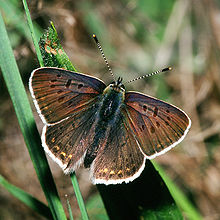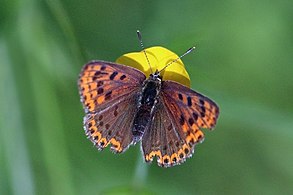429:
478:
459:
54:
75:
444:
33:
296:, but paler yellow, and with a very thin black edge instead of a broad black marginal band. Beneath yellowish grey, with very numerous black ocelli and small russet-red spots before the margin. Throughout Europe, from the North Sea to the Mediterranean, with the exception of Great Britain; also in Asia Minor. — In the much larger
291:
C. dorilis Hufn. (= circe Schiff., garbas F., phocas Rott., dorylas Kirby) (77 c) Male above black- brown, with a magnificent metallic green gloss when alive, with black spots corresponding to those of the underside and with a very thin reddish lunate line before the margin of the hindwing. Female
385:
Schultz the narrow red-yellow band of the hindwing above is continued on to the forewing also in the male— Egg semiglobular, dull green, somewhat darker at the top, coarsely punctured. Larva light green, minutely dotted with whitish, on the back occasionally with violet sheen, some specimens bear
316:
Oberth. (77d) is much brighter above, with stronger yellow variegation, and the hindwing has a short triangular tail; from
Castilia. — Also in this species specimens with abnormally dark upperside have been found: males which are devoid of the red submarginal band to the hindwing above — ab.
390:. Pupa greenish or brown, with dark dorsal line and lighter sides, with minute dark dots. The butterflies occur all through the summer, in the south in three overlapping broods, on roads among fields and on broad sunny forest-roads; they visit according to season particularly
308:
M.-Durr) (77 d) the underside is more plumbeous grey than yellowish grey, and the red submarginal spots are reduced; from the Alps. — On the other hand, the underside of
428:
897:
774:
250:, has recently been confirmed as a species on its own according to genetics, wing-pattern variation, niche modelling and distribution.
841:
702:
477:
854:
458:
892:
325:
Gillm.) — and whose females are dark like the males, also specimens with more extended light yellow area on the forewing — ab.
257:
is 28–30 millimetres (1.1–1.2 in). The butterfly flies from April to
October, depending on the location and subspecies (
859:
663:
312:
Stgr. (77 d) is more yellowish and the upperside of the female entirely blackish; from
Anterior Asia to the Altai. —
681:
779:
694:
887:
504:
Marabuto, E; Nunes, MS; Martins, R; Mendes, R; Moreira-Pinhal, TC; Raimundo, J; Seabra, SG; Paulo, OS (2023).
761:
333:
Ter Haar) —, both forms being quite inconstant. Other occasionally observed pale forms are a yellow one (ab.
410:, and, though not confined to certain flight-places, occur sometimes in large numbers together. In the Alps
285:
650:
655:
631:
186:
506:"Integrative analysis reveals the divergence and speciation between sister Sooty Copper butterflies
74:
443:
753:
593:
414:
ascends to a considerable height (Seiser Alp). In some localities dorilis flies together with
743:
377:
Wheel.), in which the hindwing above bears a row of whitish dots before the outer third, ab.
169:
805:
733:
525:
8:
53:
580:
Die Großschmetterlinge des palaearktischen
Faunengebietes, Die palaearktischen Tagfalter
529:
561:
484:
69:
62:
800:
565:
553:
386:
minute red markings. It hibernates and feeds until April and again in the summer, on
231:(Speyer, 1851) TL: Patscherkofel, Innsbruck, Austria. In the Alps at high altitudes.
882:
832:
543:
533:
272:
225:(Poda, 1761) TL: Graz, Austria. Throughout Europe from Russia to central N. Spain.
787:
465:
242:
766:
538:
505:
237:
Verity 1934 TL: Puerto de
Pajares, Asturias, Spain. In NW. Iberia and W. France.
689:
676:
876:
728:
616:
266:
668:
557:
418:
so that Mackee considers certain intermediate specimens to be hybrids (ab.
345:
Schultz the submarginal dots of the underside are modified to stripes, ab.
353:
in which the dark upperside is devoid of the coppery sheen found in fresh
715:
642:
625:
126:
846:
792:
707:
548:
210:
136:
32:
720:
206:
106:
86:
587:
826:
610:
254:
450:
246:(Oberthür, 1884) which has often been considered a subspecies of
146:
45:
469:
116:
96:
41:
582:, 1909, 379 Seiten, mit 89 kolorierten Tafeln (3470 Figuren)
503:
874:
52:
31:
547:
537:
279:
898:Taxa named by Nikolaus Poda von Neuhaus
875:
381:Wheel, is only a dwarfed form. In ab.
592:
591:
695:a44c8c3f-4301-435d-ac8d-1f68e5ed2306
13:
14:
909:
284:For a key to the terms used, see
476:
457:
442:
427:
73:
578:Seitz, A. ed. Band 1: Abt. 1,
572:
497:
1:
893:Butterflies described in 1761
491:
216:
337:Stef.) and a white one (ab.
286:Glossary of entomology terms
7:
539:10.1016/j.ympev.2022.107699
349:Wheel, is an aberration of
235:Lycaena tityrus praebleusei
10:
914:
283:
816:
600:
229:Lycaena tityrus subalpina
213:. It is found in Europe.
175:
168:
70:Scientific classification
68:
60:
51:
39:
30:
23:
261:is univoltine in July).
223:Lycaena tityrus tityrus
280:Description from Seitz
888:Butterflies of Europe
365:is represented among
690:Fauna Europaea (new)
16:Species of butterfly
530:2023MolPE.18007699M
518:Mol Phylogenet Evol
264:The larvae feed on
485:Amarante, Portugal
63:Amarante, Portugal
870:
869:
801:Open Tree of Life
594:Taxon identifiers
292:above similar to
194:
193:
905:
863:
862:
850:
849:
837:
836:
835:
809:
808:
796:
795:
783:
782:
770:
769:
767:NHMSYS0000503121
757:
756:
747:
746:
737:
736:
724:
723:
711:
710:
698:
697:
685:
684:
672:
671:
659:
658:
646:
645:
636:
635:
634:
621:
620:
619:
589:
588:
583:
576:
570:
569:
551:
541:
501:
480:
461:
446:
431:
375:purpureopunctata
359:caeruleopunctata
341:Verity). In ab.
273:Rumex acetosella
181:
78:
77:
56:
35:
21:
20:
913:
912:
908:
907:
906:
904:
903:
902:
873:
872:
871:
866:
858:
853:
845:
840:
831:
830:
825:
818:Papilio tityrus
812:
804:
799:
791:
788:Observation.org
786:
778:
773:
765:
760:
752:
750:
742:
740:
732:
727:
719:
714:
706:
701:
693:
688:
680:
675:
667:
662:
654:
649:
641:
639:
632:Lycaena tityrus
630:
629:
624:
615:
614:
609:
602:Lycaena tityrus
596:
586:
577:
573:
524:(180): 107699.
508:Lycaena bleusei
502:
498:
494:
487:
481:
472:
466:Kampinos Forest
462:
453:
447:
438:
435:Lycaena tityrus
432:
383:fulvomarginalis
289:
282:
259:L. t. subalpina
243:Lycaena bleusei
219:
198:Lycaena tityrus
190:
183:
179:Lycaena tityrus
177:
164:
161:L. tityrus
72:
25:Lycaena tityrus
17:
12:
11:
5:
911:
901:
900:
895:
890:
885:
868:
867:
865:
864:
851:
838:
822:
820:
814:
813:
811:
810:
797:
784:
771:
758:
748:
738:
725:
712:
699:
686:
677:Fauna Europaea
673:
660:
647:
637:
622:
606:
604:
598:
597:
585:
584:
571:
495:
493:
490:
489:
488:
482:
475:
473:
463:
456:
454:
448:
441:
439:
433:
426:
281:
278:
239:
238:
232:
226:
218:
215:
209:of the family
192:
191:
184:
173:
172:
166:
165:
158:
156:
152:
151:
144:
140:
139:
134:
130:
129:
124:
120:
119:
114:
110:
109:
104:
100:
99:
94:
90:
89:
84:
80:
79:
66:
65:
58:
57:
49:
48:
37:
36:
28:
27:
15:
9:
6:
4:
3:
2:
910:
899:
896:
894:
891:
889:
886:
884:
881:
880:
878:
861:
856:
852:
848:
843:
839:
834:
828:
824:
823:
821:
819:
815:
807:
802:
798:
794:
789:
785:
781:
776:
772:
768:
763:
759:
755:
749:
745:
739:
735:
730:
726:
722:
717:
713:
709:
704:
700:
696:
691:
687:
683:
678:
674:
670:
665:
661:
657:
652:
648:
644:
638:
633:
627:
623:
618:
612:
608:
607:
605:
603:
599:
595:
590:
581:
575:
567:
563:
559:
555:
550:
545:
540:
535:
531:
527:
523:
519:
515:
513:
509:
500:
496:
486:
479:
474:
471:
467:
460:
455:
452:
445:
440:
436:
430:
425:
424:
423:
421:
417:
413:
409:
405:
401:
400:Chrysanthemum
397:
393:
389:
384:
380:
376:
372:
368:
364:
360:
356:
352:
348:
344:
340:
336:
332:
328:
324:
320:
315:
311:
307:
303:
299:
295:
287:
277:
275:
274:
269:
268:
267:Rumex acetosa
262:
260:
256:
251:
249:
245:
244:
236:
233:
230:
227:
224:
221:
220:
214:
212:
208:
204:
200:
199:
188:
182:
180:
174:
171:
170:Binomial name
167:
163:
162:
157:
154:
153:
150:
149:
145:
142:
141:
138:
135:
132:
131:
128:
125:
122:
121:
118:
115:
112:
111:
108:
105:
102:
101:
98:
95:
92:
91:
88:
85:
82:
81:
76:
71:
67:
64:
59:
55:
50:
47:
43:
38:
34:
29:
26:
22:
19:
817:
601:
579:
574:
521:
517:
511:
507:
499:
434:
419:
415:
411:
407:
403:
399:
395:
391:
387:
382:
378:
374:
373:Ter Haar (=
370:
366:
362:
358:
354:
350:
346:
342:
338:
334:
330:
326:
322:
318:
313:
309:
305:
301:
297:
293:
290:
271:
265:
263:
258:
252:
247:
241:
240:
234:
228:
222:
203:sooty copper
202:
197:
196:
195:
178:
176:
160:
159:
147:
24:
18:
754:LycaenTityr
716:iNaturalist
626:Wikispecies
549:10451/59545
127:Lepidoptera
877:Categories
833:Q109585229
512:L. tityrus
492:References
420:xanthoides
396:Ranunculus
392:Potentilla
357:. The ab.
310:orientalis
248:L. tityrus
217:Subspecies
211:Lycaenidae
137:Lycaenidae
107:Arthropoda
566:255543596
416:alciphron
412:subalpina
408:Leontodon
355:subalpina
351:subalpina
329:Fuchs (=
321:S. L. (=
319:obscurior
298:subalpina
207:butterfly
155:Species:
93:Kingdom:
87:Eukaryota
827:Wikidata
751:MaBENA:
640:BioLib:
611:Wikidata
558:36621583
464:Female,
339:upoleuca
327:albicans
300:Spr. (=
255:wingspan
133:Family:
103:Phylum:
97:Animalia
83:Domain:
883:Lycaena
847:8390132
708:5882898
617:Q901019
526:Bibcode
451:Estonia
449:Kulna,
371:brantsi
369:by ab.
367:dorilis
363:phlaeas
347:brunnea
343:strandi
335:fulvior
314:bleusei
306:montana
294:phlaeas
205:, is a
189:, 1761)
148:Lycaena
143:Genus:
123:Order:
117:Insecta
113:Class:
46:Germany
860:707189
806:123534
780:266947
734:174448
721:154654
682:441198
564:
556:
483:Male,
470:Poland
404:Thymus
302:xanthe
201:, the
61:Male,
42:Saxony
40:Male,
741:LoB:
669:90400
664:EUNIS
656:82782
643:51376
562:S2CID
388:Rumex
331:nyeni
323:fusca
855:ITIS
842:GBIF
775:NCBI
744:4108
729:IUCN
703:GBIF
651:BOLD
554:PMID
510:and
437:♀ △
406:and
379:nana
304:F.,
270:and
253:The
187:Poda
793:684
762:NBN
544:hdl
534:doi
522:180
422:).
361:of
879::
857::
844::
829::
803::
790::
777::
764::
731::
718::
705::
692::
679::
666::
653::
628::
613::
560:.
552:.
542:.
532:.
520:.
516:.
468:,
402:,
398:,
394:,
276:.
44:,
568:.
546::
536::
528::
514:"
288:.
185:(
Text is available under the Creative Commons Attribution-ShareAlike License. Additional terms may apply.





